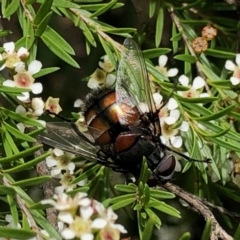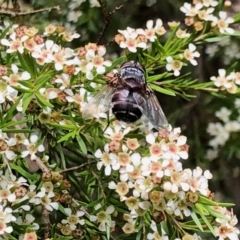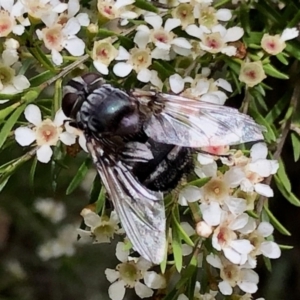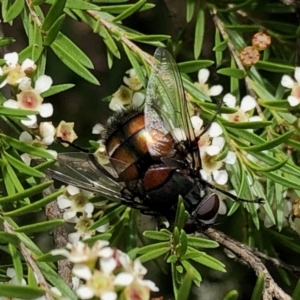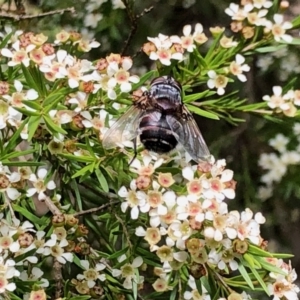A Bristle Fly at Aranda, ACT
Identification history
| Rutilia (Donovanius) sp. (genus & subgenus) | 17 Feb 2021 | MichaelMulvaney | ||
| Unidentified | 16 Feb 2021 | KMcCue |
Identify this sighting
Please Login or Register to identify this sighting.
User's notes
I am beginning to think the colour is not a true colour but a a result of diffraction in the coating of the exoskeleton - if that's what it is?
5 comments
jgl
wrote:
16 Feb 2021
For those that are curious about this, search for "Temperature effect on optical properties of the cuticle of Lucilia sericata" (Martincek et al., 2008) in Google Scholar. Can you access this article?
Like in Rutilia, the colour is structural, and results from differential interference of light in the cuticle. I'm out of my depth with the physics, but the phenomenon may or may not be analogous to a diffraction grating - maybe 'Laserchemisty' can weigh in?
From Martincek et al. (2008), p. 524 [the article which should come up in that search]:
"This terrace image suggests that the outer part of the cuticle is actually a planar multilayer structure composed of 130–150 nm thick stacking chitin layers separated by 15–20 nm thin air spacers. The spacers are provided by slight irregularities of the chitin layer surfaces. In this view, the oblique cut forms the terrace shape of the multilayer structure, so that the surface irregularities are apparent. The amplitude of these irregularities determines the air spacing between the chitin layers. Similar multilayer chitin structure with air spacers determined by irregularities of the chitin surfaces was observed in [6]. Up to fifteen chitin/air pairs could be identified from the SEM micrographs of the cuticle."
There's various theories about the utility of this colouration; while the experimental evidence seems to be conflicting, the main theory which seems to be gaining traction is that it's probably a type of camoflage, variously classified as 'distraction/flash coloration' or 'motion dazzle' (depending on the source). This camoflage interferes with a predator's (likely a bird) visual-spatial processing, reducing their striking accuracy. Again, see if you can access a free version of "Interference coloration as an anti-predator defence" (Pike, 2015), and "Towards an ecology of protective coloration" (Caro & Koneru, 2020), in Google Scholar.
Also note that, unlike Lucilia serricata in the first article, most of the Rutiliini display more than just simple iridescence. The white pollinose spots and vittae, as well as the contrasting area of dark cuticle between the iridescences likely also serve as a form of visual disruption to predators.
Like in Rutilia, the colour is structural, and results from differential interference of light in the cuticle. I'm out of my depth with the physics, but the phenomenon may or may not be analogous to a diffraction grating - maybe 'Laserchemisty' can weigh in?
From Martincek et al. (2008), p. 524 [the article which should come up in that search]:
"This terrace image suggests that the outer part of the cuticle is actually a planar multilayer structure composed of 130–150 nm thick stacking chitin layers separated by 15–20 nm thin air spacers. The spacers are provided by slight irregularities of the chitin layer surfaces. In this view, the oblique cut forms the terrace shape of the multilayer structure, so that the surface irregularities are apparent. The amplitude of these irregularities determines the air spacing between the chitin layers. Similar multilayer chitin structure with air spacers determined by irregularities of the chitin surfaces was observed in [6]. Up to fifteen chitin/air pairs could be identified from the SEM micrographs of the cuticle."
There's various theories about the utility of this colouration; while the experimental evidence seems to be conflicting, the main theory which seems to be gaining traction is that it's probably a type of camoflage, variously classified as 'distraction/flash coloration' or 'motion dazzle' (depending on the source). This camoflage interferes with a predator's (likely a bird) visual-spatial processing, reducing their striking accuracy. Again, see if you can access a free version of "Interference coloration as an anti-predator defence" (Pike, 2015), and "Towards an ecology of protective coloration" (Caro & Koneru, 2020), in Google Scholar.
Also note that, unlike Lucilia serricata in the first article, most of the Rutiliini display more than just simple iridescence. The white pollinose spots and vittae, as well as the contrasting area of dark cuticle between the iridescences likely also serve as a form of visual disruption to predators.
jgl
wrote:
16 Feb 2021
Also, there are at least 2 specimens shown in this set of observations: 1st and 3rd are female, but I'm unsure if they're the same specimen (or even conspecific); the 2nd image is of a male specimen, again, I'm unsure if it's conspecific with the 1st and 3rd images; all are Rutilia (Donovanius) sp(p).
MichaelMulvaney
wrote:
17 Feb 2021
Thanks JGL very interesting information on the razzle dazzle of Bristle Flies
KMcCue
wrote:
17 Feb 2021
Thanks jgl, most interesting. I'll have to do more reading.
How do you tell their sex?
I thought they were all the same specimen but it is quite possible that I missed a stand-in, the flowering shrub is covered in hundreds of bees and flies, though not as yet a Blue-banded Bee.
Kevin
How do you tell their sex?
I thought they were all the same specimen but it is quite possible that I missed a stand-in, the flowering shrub is covered in hundreds of bees and flies, though not as yet a Blue-banded Bee.
Kevin
jgl
wrote:
17 Feb 2021
Hi Kevin, determination of sex usually requires a priori knoiwledge of which each sex (of each species) looks like, as they're usually distinctive (once you become more familair with the specimens). However, in some cases, there's very little difference, or, opposite sexes of different species can appear quite similar. Aside from actually turning the fly over, the most obvious character is the distance between inner margins of the eyes (when viewed from above): they're always closer together in males than in females, but sometimes this difference is small, and the minimum distance for males of one species may be much larger than the males of another, so, to reiterate, you really need to be familair with everything (known to sciences) that's out there, and you need a point of reference, e.g. an entomological research collection, such as the ANIC.
I don't know about blue-banded bees, but I saw a 'neon cuckoo bee' on blosom a few blocks south of you on the 8th of Feb this year, so hopefully the other are still flying...
Cheers
I don't know about blue-banded bees, but I saw a 'neon cuckoo bee' on blosom a few blocks south of you on the 8th of Feb this year, so hopefully the other are still flying...
Cheers
Please Login or Register to comment.
Nearby sightings
Location information
- Coordinates 149.081375-35.258189
- Altitude 641.5m
- Places Aranda, ACT
Sighting information
- 4 - 15 Abundance
- 16 Feb 2021 11:52 AM Recorded on
- KMcCue Recorded by
Additional information
- 5mm to 12mm Animal size
Species information
- Rutilia (Donovanius) sp. (genus & subgenus) Scientific name
- A Bristle Fly Common name
- Not Sensitive
- Local native
- Non-Invasive
- Up to 1009.8m Recorded at altitude
- Machine learning
- External link More information
Record quality
- Overall Fit for scientific/research use
- Images or audio
- More than one media file
- Confirmed by an expert moderator
- Nearby sighting(s) of same species
- GPS evidence of location
- Description
- Additional attributes

